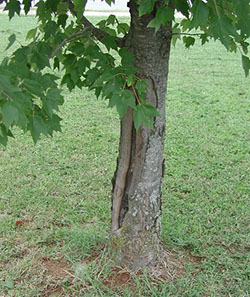Contact
Randy Forst
Extension Educator - Consumer Horticulture
Phone: (501) 671-2245
Email: rforst@uada.edu
Shrub & Tree Planting Tips
Fast Facts
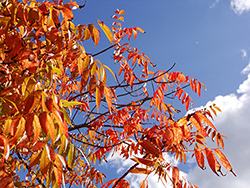
- Fall is a great time in Arkansas to plant trees and shrubs.
- Proper plant selection is critical.
- Be sure to have your soil tested for nutrient and pH levels before planting.
- It is generally not necessary to fertilize established trees and shrubs unless there is a deficiency or if stem growth and leaf color are not normal.
- Newly planted trees and shrubs will need added moisture if we don’t get regular rainfall.
- In general, the ideal time to prune ornamental trees is just before rapid growth in the spring. The time of year to prune ornamental shrubs depends on when they flower.
- Pruning is an invigorating process which puts the tree in “growth mode,” “de-hardening” the plant and making it more susceptible to winter injury.
Why Selecting the Right Tree is Important
Developing an entire new landscape, revitalizing an existing landscape or planting a single tree is an investment in your home and the environment. Investing wisely increases the return and reduces disappointment.
The process of landscaping your home begins with proper plant selection and understanding your site. Knowing which plants are best suited to the site is critical to future success. For example, hostas, ferns, bigleaf hydrangea and most azaleas are better suited to shady locations and will struggle in full sun.
Do NOT plant bradford pear trees!
How Soil Impacts your Tree's Success
A common problem in many new landscapes is poorly drained soils. In this case, we have two choices: either deal with the drainage issue or select plants that tolerate poorly drained soils. In this situation, knowing that plants such as boxwood, most evergreen hollies and evergreen azaleas will die in poorly drained sites should prompt you to avoid these plants. A clear understanding of a plant’s attributes, good and bad (e.g., plant size, flower fragrance, flowers and fruits, messy fruits, brittle wood) is needed.
Many new landscapes are over planted because homeowners did not consider the ultimate size of the plants selected. This leads to dissatisfaction, extra pruning and the inevitable need to replace or severely prune the plant. Placing a large shade tree close to the corner of a house or a shrub growing to 12 feet beneath a four-foot window does not make sense long term. Be sure that the mature plant size will fit the site.
Know your planting site!
Before purchasing plants or planting them, you need to know several things about the planting site. Issues such as sun exposure, soil pH, drainage, and location of utilities need to be considered. Start with the soil. Significant changes to the soil are easy prior to planting the landscape.
Have your soil tested before planting.
It is easy and will provide useful information that will improve the long-term success of your landscape. Soil samples can be submitted at your local county Cooperative Extension office. One of the most important pieces of information gained from a soil test is the soil pH. The soil test report indicates the current soil pH (acid or alkaline) and makes a recommendation based on the plant type if a change is required. Soil analysis is even more important if other plants in the landscape are having problems.
Check the soil’s drainage with a simple percolation test. The rate at which water drains through the soil affects plants’ survival and growth. Poorly drained soil results in too much water in the root zone and a lack of needed oxygen for healthy roots.
How to determine percolation (water drainage) rate
- Dig a hole 1 foot deep, fill with water, and see how long it takes to empty.
- If the water level drops more slowly than 1 inch per hour, drainage is poor.
Poorly drained sites can be corrected by proper plant selection, installing a drainage system, elevating plants, or planting beds above the affected area.
Check for underground utilities and obstructions before digging!
- Before digging, make sure you know the location of buried and above-ground utilities.
To check for utility obstructions call 811 or visit the AR 811 website.
- Never place any tree growing taller than 15 feet beneath power lines or within 15 feet of them. Under ideal conditions, keep trees away from utility wires a distance equal to the mature spread of the tree being planted. For example, if the branch spread on a mature tree will be 30 feet, plant the tree 30 feet away from overhead utility lines.
- Do not plant too close to surrounding objects including houses, barns and other trees. Remember that tree roots spread well beyond the branch area of the tree and roots can interfere with foundations, sidewalks, and paved areas.
Preparing the Planting Hole
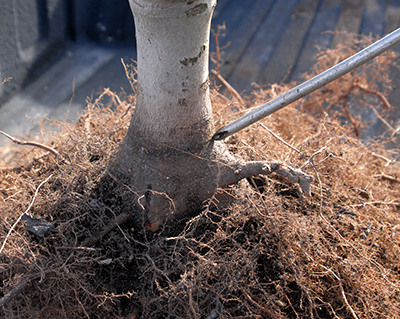
- Start the planting process by clearing vegetation and mulch from the site at least 6 inches beyond the proposed hole or bed.
- For normal planting in well-drained soil, the hole for an individual plant should be at least one-and-a-half to two times the width of the root ball and only as deep as the root ball or soil mass.
- Discoloration on the bark near ground level of bare-root plants indicates the soil level at which they originally grew.
- Do not dig the hole deeper than the root ball. If the top of the root ball is set below the surface of surrounding soil, even by only 3 inches, water can collect in the planting hole, resulting in a lack of oxygen to the roots. If a deeper hole is dug and then filled with loose soil, the plant can eventually settle below the soil surface level.
- In poorly drained or compacted soil, make the hole three to four times the width of the root ball and not quite as deep as the root ball.
- When planting on steep slopes, set the plant so the top of the root ball on the uphill side is about even with the soil. The side of the root ball on the downhill side will be well above the surrounding soil.
Planting a Balled and Burlapped (B&B) Tree
B&B plants are field-grown trees and shrubs that are dug, the soil ball wrapped in burlap, and then laced up with string or rope. Many large trees also have a heavy-gauge wire basket outside the burlap wrapping to help stabilize the soil around the tree roots.
- In a majority of cases, the burlap fabric is biodegradable. In those very rare cases, if the burlap is made from plastic, it must be removed as far down the root ball as possible so the root ball is in direct contact with the backfill soil. Roots will not grow through the synthetic burlap material.
- In Arkansas, biodegradable or natural burlap can be left along the sides of the root ball since it will naturally break down.
- Burlap and any rope or tie material, whether natural or synthetic, that is located at the top of the root ball should be removed.
- Materials that are in direct contact with the trunk are of special concern as they may eventually girdle the trunk.
- Synthetic materials may be difficult to distinguish from natural materials. Synthetic rope is usually orange and synthetic burlap is typically a slick green or tan. A simple test involves burning a small portion of rope or burlap with a match. Synthetic materials will melt but not really burn.
What if my tree comes with a wire basket outside the burlap?
Most large trees are sold with a wire basket outside the burlap wrap. The wire basket is designed to help in the shipping and handling of these heavy root balls. Wire baskets degrade slowly in soil. There is a great deal of discussion whether to remove all or some portion of the wire basket from the root ball. The wire basket does present a potential risk to the operator of a stump grinder if the stump is ground before the wire fully degrades.
While most research shows that the wire basket has little effect on trees, most horticulturists recommend removing at least the top 12 to 18 inches (two or three levels) of wire from the root ball. This allows the major roots and trunk to grow without possibility of becoming girdled by the wire. A bolt cutter or heavy wire cutter makes the job quick and easy. Since most roots grow in the upper 12 inches of soil, few if any roots would be potentially girdled by the lower portion of the basket.
What is the purpose of the burlap, rope, and basket (if present)?
They are used to keep the field soil in close contact with the roots. Extensive handling of the root ball or unnecessary removal of these materials may damage the plant’s root system.
When should I remove these materials?
It is best to remove them once the root ball has been placed in the planting hole. This may require that the top of the planting hole be widened to provide access to remove burlap and wire basket materials. If the tree you purchased has black trunk wrap, remove that at planting.
How to Plant a Container-grown Tree
A majority of ornamental plants are now sold in containers. The shift to container-produced plants offered several advantages, including increased availability and improved handling of plants, and made certain plants available that did not respond well to B&B production. Rather than growing in field soils, container-grown plants use organic materials such as compost, peat moss, and bark.
It would seem obvious, but the container must be removed before planting. Removing plants from containers can be accomplished several ways.
- Plants grown in thin-walled pots (blow molded; fiber pots) can be removed by cutting or slicing the container walls.
- On thicker-walled containers it is better to slide the pot off the root ball. This may be difficult for pot-bound (or root-bound) plants. In that case, laying the pot on its side and then pushing down on the pot in several quadrants may help separate the root mass from the container wall.
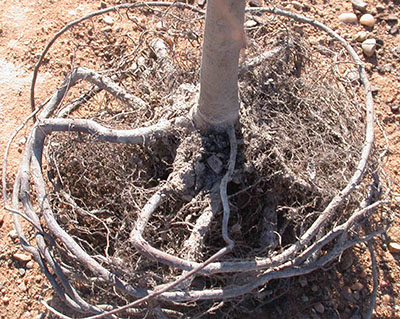
What is root circling?
Once the pot has been removed, determine if there are extensive roots circling the outside of the root ball (see photo).
Plants with extensive or excessive root development at the outer edge are referred to as root-bound or pot-bound. These circling roots continue to increase in diameter and can eventually strangle the trunk of a tree.
What should I do if the root circling is extensive?
These roots should be cut with a knife or sharp spade. Make three or four slices an inch or two deep starting from the top of the root ball to the bottom. For very large containers (e.g., 15-gallon and larger), pay particular attention to circling roots in the upper one-half or one-third of the root ball. Recent studies show that slicing the root ball does appear to enhance the distribution of regenerated roots in the backfill soil profile. Instead of growing almost exclusively from the bottom of the root ball, slicing encourages root regeneration along the sliced sectors.
Planting a Bare-root Plant
In Arkansas, there are very few woody plants sold bare root. Bare-root plants are grown in a field, harvested in the fall by removing all of the field soil, graded, stored in large refrigerated rooms and then shipped in very early spring. The most common bare-root plants sold in Arkansas are roses and fruit trees. Other bare-root plants include fruit plants (e.g., strawberries), herbaceous perennials and some groundcovers. The bare roots are packed with a shipping material such as cellulose strands or peat moss and then sealed in a plastic tube or bag. Bare-root plants are less expensive, but much more perishable, than container or B&B plants.
- Bare-root material should be planted as soon as possible after purchase.
- Make sure the roots do not dry out or freeze.
- After removing the packing bag, remove any packing material carefully from the roots.
- Inspect the roots for any diseased, broken or dead roots and remove any of these roots with pruning shears prior to planting.
- Shorten exceptionally long roots.
- Immerse the roots in a bucket of water for at least one hour.
- Make a cone-shaped mound in the center of the planting hole.
- Position the plant so that it’s at the correct depth. Discoloration on the bark near ground level of bare-root plants indicates the soil level at which they originally grew. For most grafted plants such as fruit trees, the graft union will likely be one to three inches above the ground level.
- Spread the roots as evenly as possible in the hole. Bare-root trees are more likely to require staking following planting than container or B&B plants.
Get Tips for Planting a Bare Root Tree from Faulkner County Agent Krista Quinn
Planting a Tree Seedling from a Ripening Nut, Acorn, or Fruit
If you have plans to start a tree seedling from that favorite oak, buckeye, or any other tree with ripening nuts, acorns or fruit, collect these seeds as soon as they ripen and plant them immediately. If left to dry just for a few days, the young embryo inside will no longer have the ability to germinate.
They can be stored in the refrigerator, in a zip lock with moist sand or peat moss, until you get a chance to plant them in an outdoor container or in their permanent spot in the ground.
Amendments at Planting and Backfilling
The value of amending backfill soil when planting trees and shrubs has been debated for decades. In all but exceptional circumstances where the soil is very poor, extensive research has shown no need to incorporate any amendments, fertilizers, living organisms, water-holding gels, humic acids, or organic products into the backfill soil. Simply use the loosened soil that came out of the planting hole. Loosen and break up large clods of soil and remove large rocks before Backfilling.
The exception to not adding backfill amendments is where existing soil is so poor (e.g., mine spoil, small cutout in a concrete sidewalk, parking lot island) that all soil in the area needs to be replaced with good quality soil. Incorporation of organic matter when planting in very sandy or gravelly soils will also increase the water-holding capacity. If results from a soil test indicate the pH needs to be adjusted, incorporating acidifying (e.g., sulfur) or liming (e.g., limestone) materials in the backfill amendment at planting is most efficient. If the soil does require a significant change in pH, follow-up tests in subsequent years are encouraged to monitor any changes.
Fertilizing your Newly Planted Tree
It is generally not necessary to fertilize established trees and shrubs. If you do, wait to fertilize until late October or early November, or better yet, apply in late winter (Feb-March). Early fall fertilization may produce a flush of late, weak growth that will not harden off properly, predisposing new growth to winter injury.
Adding slow-release fertilizer of any type at planting has never been associated with improved or reduced survival. There are only a few documented cases of increased growth when fertilizer was applied at or soon after planting. A response to fertilizer at planting is most likely to occur in sites with poor soils.
Avoid using soluble fertilizers or manures when planting bare-root plants as the salts can damage the roots. When fertilizer is applied, spread the amount as indicated by the manufacturer on top of the root ball after planting or on top of the mulch. Plants may require fertilizer after the establishment year depending on results from a soil test or based on the planting situation.
Irrigation is critical to your tree's success!
Adequate irrigation after planting is the most critical factor in determining success after planting. Water every plant immediately after planting. Unlike established plants, research clearly shows that recently transplanted plants establish faster with light, frequent irrigation. The actual amount of water will need to be adjusted based on the weekly precipitation. In Arkansas, during the summer months, newly transplanted plants may require supplemental irrigation several times per week. The actual amount of water will depend on the type of soil and size of plant. As an example, a 2-inch tree may require 4 gallons of water distributed evenly over the root ball every irrigation.
Plants can be killed just as easily by over watering as under watering (drought). When in doubt, feel the soil in the planting area to see if it is moist.
Mulching your Tree
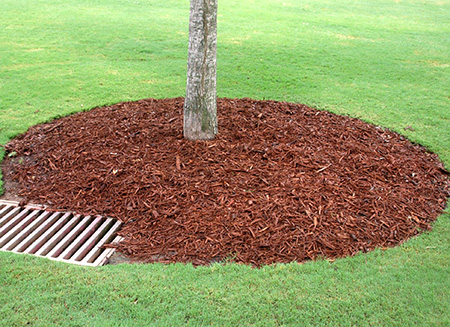
Somehow, the concept of mulching has gotten out of hand. Over the past 30 years there has been a shift from no mulch to “volcano” mulching.
Mulching offers many advantages including:
- reducing weeds
- protecting the trunk from string trimmer damage
- conserving soil moisture and adding organic matter to the soil.
Research has shown a dramatic increase in tree growth when a small area above the root ball is maintained free of vegetation.
Placement of Mulch
The depth of an organic mulch should not exceed 3 inches after settling. Never pile mulch against the trunk. Mulch resting on the trunk and applying too thick a layer may result in increased stem and root diseases, may harbor rodents that feed on the trunk and may reduce the oxygen required by roots.
Type of Mulch
A wide variety of products are available for use as landscape mulch. Mulch can be broadly categorized as either organic or inorganic. Common inorganic mulch materials include crushed stone, recycled tire chips and gravel. Organic materials include pine needles, softwood or hardwood tree bark, colored wood chips, composted yard waste, and cottonseed hulls.
Why does my bark mulch have an odor?
A rare problem with bulk hardwood mulch is something called “sour mulch.” Hardwood bark that has been held in a large pile is most susceptible to this problem. Anaerobic conditions in the large pile cause a buildup of gases that can burn foliage on plants when spread as a mulch layer.
Bark that has a noticeable odor or causes your eyes to burn should not be immediately spread under plants. Instead, spread the mulch in a non-plant area to ventilate the harmful vapors. For 3 inches of spread mulch, a 2 cubic foot bag will cover 8 square feet, a 3 cubic foot bag will cover 12 square feet and a 1 cubic yard (27 cubic foot) bulk load will cover 108 square feet.
Should I stake my tree?
Do not stake trees unless it is absolutely necessary. Stake only for special situations such as high-wind areas, very sandy soils, very large or top-heavy trees, or for protection from vandalism, heavy foot traffic, or equipment damage. Otherwise, allow the tree to develop naturally, strengthening as it grows.
Hybrid Red Maples: Preventing South West Injury
Hybrid red maples are in full glory during the fall. If you have one of these and you planted it in the past 3 years, you need to take preventative action this fall so you will not end up with South West injury.
This trunk injury happens because these young red maple hybrids have very thin bark which allows the trunk to warm up with the sun striking the trunk on the SW side. The cambium layer on that side starts to divide and grow on a warm winter day thinking spring is near, but subsequent low temperatures are sure death to this portion of the cambium.
You can give your young red maple “fake bark” by wrapping the trunk with a light colored wrap up to or beyond the first limbs. Tree wraps need to be removed at spring green up. Repeat this each fall for up to 3 years to protect young trees from being scarred for life. Once these trees get some age on them, the bark becomes thicker and corky which will prevent cambium from starting to grow prematurely.
Read more about sunscald and southwest injury.
Additional Tree and Shrub Resources
- Pruning Trees and Shrubs
- Sunscald on Trees
- 3D's of Successful Backyard Habitat | Diversity, Design, & Diligence
- Ten Easy Ways to Kill a Tree and How to Avoid Them
